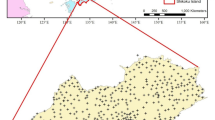Abstract
The study area comprises the southeastern part of the Western Desert of Egypt. The aims of the present study are to delineate the major surface and subsurface structures and to evaluate tectonic framework of the study area. Surface studies of the present work are based mainly on data from two different types of remote sensing systems: 15 cloud-free Landsat Enhanced Thematic Mapper Plus (ETM+) images and Shuttle Radar Topography Mission (SRTM) DEM data. The remote sensing data were used to recognize and extract geological lineaments by calculating and interpreting DEM derivatives, including shaded relief maps, slope maps, and traverse profiles. A Bouguer anomaly map (scale 1:500,000) was used to delineate a detailed picture of the subsurface structure in the study area. The analysis of surface data, including SRTM DEM and ETM+, was combined with subsurface data, including Bouguer anomaly map, and gave new insight into the tectonic and structure patterns of the study area.











Similar content being viewed by others
References
Abdel Zaher M, Senosy MM, Youssef MM, Ehara S (2009) Thickness variation of the sedimentary cover in the south western desert of Egypt as deduced from Bouguer gravity and drill-hole data using neutral network method. Earth Planet Space 61:659–674
Al Fastawi YA, Van Dijk PM (1990) Lineament and geomorphic analysis of remote sensing data as an aid to hydrocarbon exploration, Sirt Basin, Libya. ITC Journal: Bulletin de l’ITC 2:137–144
CGIAR Consortium for Spatial Information (2005) http://srtm.csi.cgiar.org/
Chuanyan Z, Zhongren N, Zhaodong F (2004) GIS-assisted spatially distributed modeling of the potential evapotranspiration in semi-arid climate of the Chinese loess plateau. J Arid Environ 58:387–403
Conoco Coral (1987) Geological map of Egypt, scale 1:500,000. The Egyptian General Petroleum Corporation (EGPC), Cairo
Cordell L (1979) Gravimetric expression of graben faulting in Santa Fe Country and the Espanola Basin, New Mexico. In: Ingersoll RV (ed) Guidebook to Santa Fe Country, 30th Field Conference. New Mexico Geological Survey, Socorro, pp 59–64
Cordell L, Grauch VJS (1985) Mapping basement magnetization zones from aero-magnetic data in the San Juan Basin, New Mexico. In: Hinz WJ (ed.) The utility of regional gravity and magnetic anomaly maps. Society of Exploration Geo-physicists, Tulsa, 181–197
Demirkesen AC (2008) Digital terrain analysis using Landsat-7 ETM+ imagery and SRTM DEM: a case study of Nevsehir province (Cappadocia) Turkey. Int J of Rem Sens 29:4173–4188
Egyptian General Petroleum Corporation (EGPC) (1980) Bouguer anomaly map of South Western desert of Egypt, scale 1:500,000. EGPC, Cairo
Ganas A, Pavlides SB, Karastathis V (2005) DEM-based morphometry of range-front escarpments in Attica, central Greece, and its relation to fault slip rates. Geomorphology 65:301–319
Grauch VSJ (1987) A new variable-magnetization terrain correction method for aeromagnetic data. Geophysics 52:94–107
Grauch VSJ, Cordell L (1987) Limitations of determining density or magnetic boundaries from the horizontal gradient of gravity or pseudogravity data. Geophysics 52:118–121
Jenson SK, Domingue JO (1988) Extracting topographic structure from digital elevation data for geographic information system analysis. Photo Eng and Rem Sens 54:1593–1600
Masoud A, Koike K (2006) Tectonic architecture through Landsat-7 ETM+/SRTM DEM-derived lineaments and relationship to the hydrogeologic setting in Siwa region. NW Egypt J of Afr Ear Sci 45:467–477
Mather PM (2004) Computer processing of remotely-sensed images, 3rd edn. Wiley, Chichester
Nagy RM, Ghuma MA, Rogers JW (1976) A crustal suture and lineament in North Africa. Tectonophysics 31:67–72
Nama EE (2004) Lineament detection on Mount Cameroon during the 1999 volcanic eruptions using Landsat ETM. Int J of Rem Sens 25:501–510
Neev D (1977) The Pelusium line, a major transcontinental shear. Tectonophysics 38:1–8
Phillips JD (1998) Processing and interpretation of aeromagnetic data for the Santa Cruz Basin—Patahonia Mountains area, South-Central Arizona. U.S. Geological Survey Open-File Report, 02-98
Rabus B, Eineder M, Roth A, Bamler R (2003) The shuttle radar topography mission—a new class of digital elevation models acquired by spaceborne radar. J of Photo and Rem Sens 57:241–262
Riad S (1977) Shear zones in north Egypt interpreted from gravity data. Geophysics 24:1207–1214
Rowland SM, Duebendorfer EM (1994) Structural analysis and synthesis, 2nd edn. Blackwell Scientific, Palo Alto
Rowan LC, Lathram EH (1980) Mineral exploration, chapter 17. In: Siegal BS, Gillespie AR (eds) Remote sensing in geology. Wiley, New York, pp 553–605
Saadi NM, Abdel Zaher M, El-Baz F, Watanabe K (2011) Integrated remote sensing data utilization for investigating structural and tectonic history of the Ghadames Basin, Libya. Int J of App Ear Obs and Geo 13:778–791
Said R (1962) The geology of Egypt. Elsevier, Amsterdam
Schandelmeier H, Huth A, Harms U, Franz G, Bernau R (1987a) The east Saharn Craton in southern Egypt and Northern Sudan. BerlGeowiss Abh A 75:25–48
Schandelmeier H, Klitsch E, Hendriks F, Wycish P (1987b) Structural development of northeast Africa since Pre-Cambrian time. BerlGeowiss Abh (B) 75:5–24
Schowengerdt RA (2007) Remote sensing: models and methods for image processing, 3rd edn. Academic, London
Silverman BW (1986) Density estimation for statistics and data analysis. Chapman and Hall, New York
Smith MJ, Clark CD (2005) Methods for the visualization of digital elevation models for landform mapping. Earth Surf Process Landforms 30:885–900
Thorweihe U (1990) Nubia aquifer system. In: Said R (ed) The geology of Egypt, 2nd edn. Balkema, Rotterdam
Wycisk P (1987) Contribution to the subsurface geology of the Misaha trough and the Southern Dakhla Basin. BerlGeowiss Abh (A) 75:137–150
Acknowledgments
We would like to acknowledge the Geoelectric and Geothermal Laboratory, National Research Institute of Astronomy and Geophysics, Helwan, Egypt for providing us with an excellent environment and facilities to perform this work.
Author information
Authors and Affiliations
Corresponding author
Rights and permissions
About this article
Cite this article
Abdel Zaher, M., Saadi, N.M. & Watanabeb, K. Geological applications potential of DEM, ETM+, and gravity data in arid and semi-arid regions with special reference to south Western Desert, Egypt. Arab J Geosci 7, 1705–1716 (2014). https://doi.org/10.1007/s12517-013-0847-z
Received:
Accepted:
Published:
Issue Date:
DOI: https://doi.org/10.1007/s12517-013-0847-z




